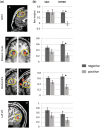Can we share the joy of others? Empathic neural responses to distress vs joy
- PMID: 22156723
- PMCID: PMC3501705
- DOI: 10.1093/scan/nsr073
Can we share the joy of others? Empathic neural responses to distress vs joy
Abstract
The neural bases of empathy have been examined mainly in the context of reacting to others' distress, while almost no attention has been paid to the mechanisms by which we share others' joy. Using functional magnetic resonance imaging, we demonstrated that the same neural network mediates judgment of the emotional state of the other in response to both negative and positive events through empathy-related structures, such as the medial prefrontal cortex (MPFC), the insula, the superior temporal sulcus (STS) and the inferior frontal gyrus (IFG). However, the responses of the MPFC, bilateral insula and the right IFG to negative experiences occurring to the other (but not to the self) were found to be much more intense than the responses to positive experiences, indicating that humans have a remarkable ability to share the distress of others, but may react less to the joy of others.
Figures


Similar articles
-
Intrinsic functional network contributions to the relationship between trait empathy and subjective happiness.Neuroimage. 2021 Feb 15;227:117650. doi: 10.1016/j.neuroimage.2020.117650. Epub 2020 Dec 15. Neuroimage. 2021. PMID: 33338612
-
The good, the bad, and the suffering. Transient emotional episodes modulate the neural circuits of pain and empathy.Neuropsychologia. 2018 Jul 31;116(Pt A):99-116. doi: 10.1016/j.neuropsychologia.2017.12.027. Epub 2017 Dec 16. Neuropsychologia. 2018. PMID: 29258849
-
Mirror neuron and theory of mind mechanisms involved in face-to-face interactions: a functional magnetic resonance imaging approach to empathy.J Cogn Neurosci. 2007 Aug;19(8):1354-72. doi: 10.1162/jocn.2007.19.8.1354. J Cogn Neurosci. 2007. PMID: 17651008
-
Is there a core neural network in empathy? An fMRI based quantitative meta-analysis.Neurosci Biobehav Rev. 2011 Jan;35(3):903-11. doi: 10.1016/j.neubiorev.2010.10.009. Epub 2010 Oct 23. Neurosci Biobehav Rev. 2011. PMID: 20974173 Review.
-
Meta-analytic evidence for common and distinct neural networks associated with directly experienced pain and empathy for pain.Neuroimage. 2011 Feb 1;54(3):2492-502. doi: 10.1016/j.neuroimage.2010.10.014. Epub 2010 Oct 12. Neuroimage. 2011. PMID: 20946964 Review.
Cited by
-
A novel approach to measure brain-to-brain spatial and temporal alignment during positive empathy.Sci Rep. 2022 Oct 14;12(1):17282. doi: 10.1038/s41598-022-18911-4. Sci Rep. 2022. PMID: 36241665 Free PMC article.
-
Age, empathy, familiarity, domestication and call features enhance human perception of animal emotion expressions.R Soc Open Sci. 2022 Dec 7;9(12):221138. doi: 10.1098/rsos.221138. eCollection 2022 Dec. R Soc Open Sci. 2022. PMID: 36483756 Free PMC article.
-
Their pain gives us pleasure: How intergroup dynamics shape empathic failures and counter-empathic responses.J Exp Soc Psychol. 2014 Nov 1;55:110-125. doi: 10.1016/j.jesp.2014.06.007. J Exp Soc Psychol. 2014. PMID: 25082998 Free PMC article.
-
Situating emotional experience.Front Hum Neurosci. 2013 Nov 26;7:764. doi: 10.3389/fnhum.2013.00764. eCollection 2013. Front Hum Neurosci. 2013. PMID: 24324420 Free PMC article.
-
Enduring maternal brain changes and their role in mediating motherhood's impact on well-being.Sci Rep. 2024 Jul 18;14(1):16608. doi: 10.1038/s41598-024-67316-y. Sci Rep. 2024. PMID: 39025996 Free PMC article.
References
-
- Amodio DM, Frith CD. Meeting of minds: the medial frontal cortex and social cognition. Nature Reviews Neuroscience. 2006;7(4):268–77. - PubMed
-
- Batson CD, Batson JG, Slingsby JK, Harrell KL, Peekna HM, Todd RM. Empathic joy and the empathy-altruism hypothesis. Journal of Personality and Social Psychology. 1991;61(3):413–26. - PubMed
-
- Blair RJ. Dissociable systems for empathy. Novartis Foundation Symposium. 2007;278:134–41. discussion 141–35, 216–121. - PubMed

